
What makes a prospective student a perfect candidate for your school? At what point should you contact them? And what follow-up approaches are most likely to achieve the best results?
These are the questions that lead scoring can help you answer. By assigning a numeric value to each of your prospective students based on their suitability and level of interest, your school can prioritize your workload more efficiently, work towards your targets with more clarity, and follow up with the right potential applicants at the right time.
The difficulty, of course, is figuring out how to score them. Since different schools will need to place importance on different criteria, there is no standardized model for putting together a student recruitment lead scoring framework. As a result, many institutions end up assigning arbitrary values based on their personal judgement, resulting in inefficient, ineffective models.
Here’s how you can bring a bit more order to the process.
Begin by Considering Your Minimum Enrollment Criteria
The first step in developing an accurate lead scoring framework is also arguably the simplest. As a starting point, you should consider the essential criteria a prospective student has to meet to qualify as a viable lead. Not your ideal characteristics, or even the most typical among your target audience; just the bare minimum requirements a student needs to meet to be eligible to enroll in your programs.
Does a student need to be over 18 to attend your institution? Must they have a certain level of previous education, like a high school diploma or bachelor’s degree? Do they need to meet certain visa requirements, or have a sufficient budget for their studies?
Example: ESL school Language Systems asks students to specify in their landing page forms whether or not they have a $1,000 per month budget for study. Using a lead scoring system, this strategy could potentially allow them to weed out ineligible leads at the point of capture.
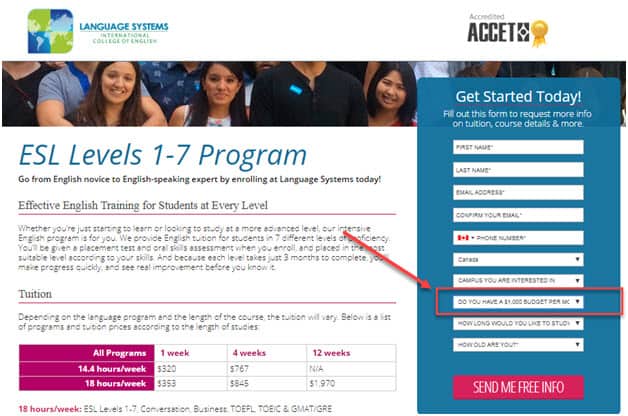
It’s most likely that you will have very few of these basic qualification factors, if any. If you are in doubt about whether something falls into this category, then it probably doesn’t.
Once you have identified these attributes, you should assign a high numeric value to them in your lead scoring system. For instance, if you have a minimum age of 18, you may want to assign 50 points to any lead over that age.
This will mean that only leads who meet these basic criteria are passed to your recruitment team for further follow-up. It can also help you identify web visitors who are not prospective students, but may sign up to receive information from your school, such as competitors or people conducting independent research.
That doesn’t mean that any lead that falls short of this score should be automatically discarded. An eligible prospective student could make a mistake when filling out a form, or a parent inquiring on behalf of their child could input their own details instead, giving you misleading information. Have someone on your admissions team take the time to review these leads manually to ensure that the story your lead scoring is telling is correct, and that quality leads don’t slip through the cracks.
Using Student Lead Scoring for Segmentation and Prioritization
A student lead scoring system should be used as a tool to prioritize your inquiries so that they are worked by the right person in a timely manner. With that in mind, it is often helpful to assign scores to certain criteria in order to segment and classify your leads with more clarity.
How you segment your leads will depend on your specific needs. For some schools, it may be efficient to divide prospective students by program, while others may want to divide them by location. If you are a smaller institution, or are offering only a limited amount of programs, it may not be necessary to segment them at all. CRM systems can also be configured to automatically segment leads in different categories, making this step less essential.
Example: An example of the segment view in the Mautic CRM. These segments apply to a language school, and are divided by sent applications, students aged 17 or over with a study visa, and Portuguese and Spanish speakers. Your CRM should provide the basis for your segmentation process, with lead scoring complementing it.

Nonetheless, lead scoring can help you assign higher priorities to the segments you consider more valuable, or even create sub-segments for different categories within your top-level CRM segments. Many experts advocate using a thousand-digit scoring system for this purpose. In this approach, a prospective student who falls into one of your segments would automatically be assigned 1,000 points, while one who fits into another would be given 2,000 points, and so on. As a result, leads would always be easily identifiable as belonging to a certain segment by the first digit in their score (1089, 2135, etc.).
This can be helpful if you have certain team members who are assigned to follow up with students in particular locations, certain languages, or specific programs. If you want to prioritize a certain program, perhaps to improve its enrollment numbers, this system can also make it easier to sort and prioritize your workflow queue.
If you do feel the need to classify leads in this way, you should keep in mind that it may need to be done in tandem or even before you establish your minimum qualification criteria, as these attributes may vary across different segments. For example, a university will have different education level requirements for undergraduate and postgraduate degrees, and would need to tweak their minimum criteria to segment scores by program or level.
Assigning Lead Scores to Find Your Ideal Students
Once you have completed these initial steps, it’s time to start looking at other possible attributes that could influence the value of a prospective student. This will involve considering the demographic makeup of your typical target market, as well as any new markets you wish to tap into, and the characteristics you consider ideal for applicants to possess.
At the heart of this process is good student persona development. Well-researched, detailed personas should act as a guiding point for your lead scoring efforts, with prospective students who best match them rewarded accordingly in your matrix.
As an example, let’s look at this persona for an international applicant looking to study in Canada:
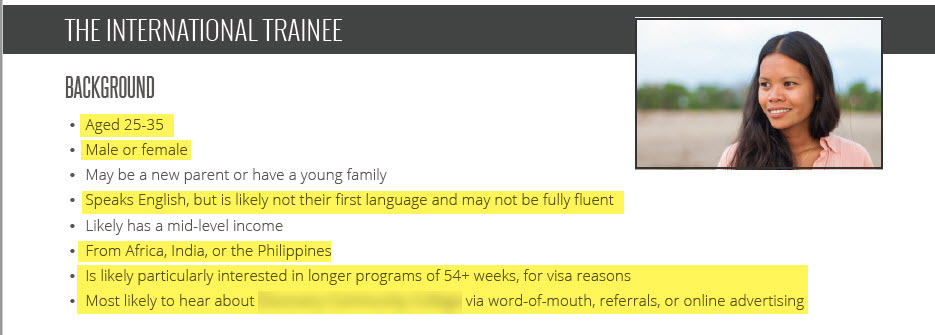
All of the highlighted parts above are potentially scorable attributes. The ‘Background’ section lists a number of demographic points which could prove relevant, including the student’s:
- Age
- Gender
- Language
- Location
- Desired course length
- Source channel
Other parameters you may want to assign a value to could include a lead’s level of education, their employment experience, job title, and industry. Some schools will also often ask prospective students to specify the reasons they are interested in a specific program, which could also be assigned a value.
Ideally, you should be looking to obtain as much of the most crucial information you need as possible in your online forms, so that your admissions team can score each prospective student accurately from the very beginning.
Example: The Haas School of Business at the University of California, Berkeley ask students to specify their ‘future industry’ in their online inquiry form, something which could be very instructive for lead scoring purposes.
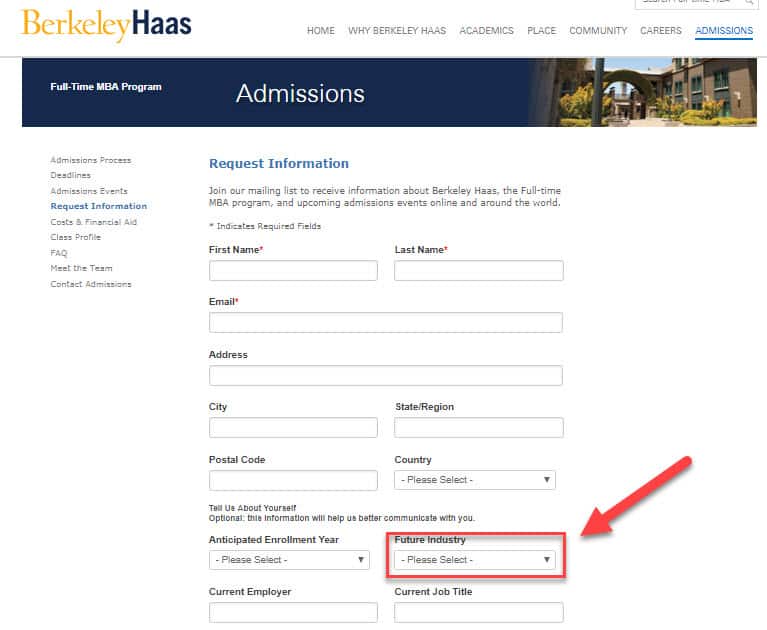
How you weight these attributes in your lead scoring system will depend on how valuable they are to you. A good place to start is to try and reverse engineer your target personas, evaluating how common each of the attributes are among your current and past students in order to estimate how important it is likely to be in your student lead generation efforts.
Scoring Prospective Student Behaviours and Interactions
Determining when and how to prioritize following up with a prospective student is about more than whether they are a good fit for your school. You must also consider how interested they are in applying, and how far they have progressed in their decision-making process.
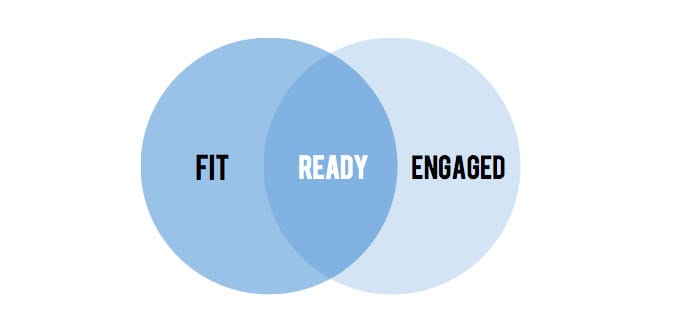
You can evaluate these by looking at both a lead’s online behaviour and their interactions with your school. In the former category, you can use CRM reporting tools to track web browsing behaviours of individual users, as well as any actions they take such as downloading a brochure or watching a video. Some CRM systems will also allow you to identify and link a prospect’s social accounts to their profile in order to record page likes, comments, shares, or mentions. Each of these actions can be assigned a value in your lead scoring system, so that a prospective student’s score increases the more interest they show in your school.
You can also monitor their response to contact by logging replies to calls and text messages in your CRM system, and tracking email open and click-through rates.
Example: HubSpot allows you to assign scores for marketing email activities.

While each of these actions can be taken as indication of interest, it is important to weight them correctly. Properly determining how to do this may involve a deep dive into your analytics data. One possible report which could prove helpful is the Reverse Goals Path report in Google Analytics, which will give you some insight into which pages users visited before completing specific goals:
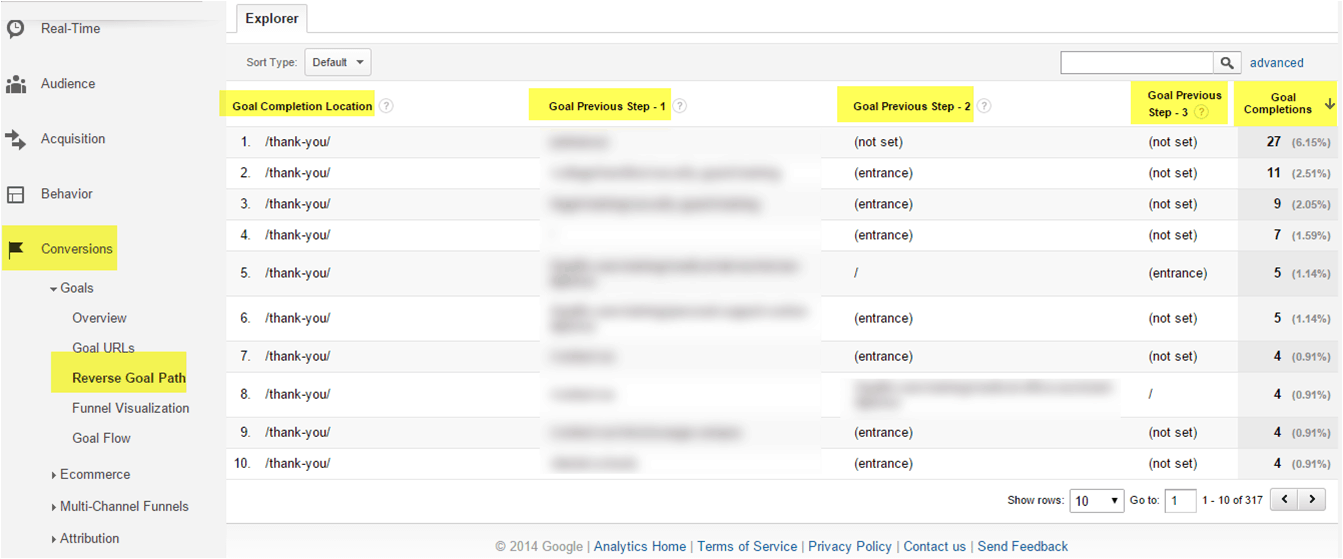
This could potentially help you to assign specific values to different web page visits. The Channel Report can also be helpful in determining which channels are more likely to lead to conversions:

You CRM report can also help you to evaluate how indicative certain actions are of serious interest. Hubspot, for instance, will allow you to run an attribution report which can help you determine your most common paths to conversion.
Example: A Hubspot Attribution Report showing closed deals by URL.

Analyzing this data will make it easier to assign scores to actions which are appropriate to their actual value, and reduce the risk of prospective students building up inaccurately high totals.
Negative Student Lead Scoring and Score Degradation
Not every lead who shows serious interest in your school will pan out. Some will choose other institutions, while others will be unable to overcome certain barriers to enrollment, and a few will simply change their minds.
With this in mind, it’s essential that your lead scoring system is flexible enough to adjust over time, as the interest levels of the prospects in your system fluctuates. It can be possible, for instance, for a lead with very low interest in your school to accumulate a high score over time through repeated casual interactions like opening emails, reading blogs, or liking social media posts. Likewise, a seriously interested prospective student that decides against applying could theoretically remain at the top of your follow-up list for a long period after they are no longer a viable lead if they have amassed a high score.
To keep your scores reflective of actual interest, experts recommend making provisions for negative scoring and score degradation. Score degradation involves reducing a lead’s score after a defined period of time. Your school could include a reduction in score after a certain period of inactivity, allowing prospects whose interest has waned to gradually slip down the priority list.
Negative scores could also be attributed to activities which indicate a lack of interest. For instance, prospective students who unsubscribe from your mailing list should probably be given a negative score. Your school may also choose to assign negative scores to leads who are unresponsive to contact, fail to meet certain criteria, or take action on social media that indicates they may be losing interest, such as unfollowing your account.
This will keep your scoring system representative of the true value of your pipeline, and also help you pinpoint areas where prospects are dropping out of your funnel in order to better refine your education lead generation and nurturing processes.
Putting Together Your Student Lead Scoring Matrix
Following the steps outlined above should give you a good indication of how to weigh your lead scoring attributes. From there, you can assemble a basic matrix which takes into account your school’s most important values, beginning with the most essential attributes and progressing towards different positive and negative actions.
Example: A lead scoring matrix developed for an MBA program.
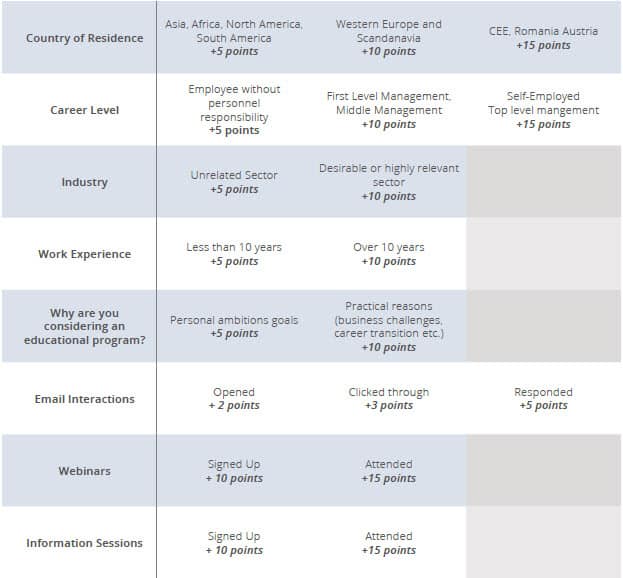
While lead scoring can offer you a tremendous amount of insight, it’s important not to take it as gospel. Just as everyone is different, so too is their online behaviour, and a lead score might not tell the full story about a prospective student’s eligibility and interest. Nonetheless, by making contact with as many prospective students in your pipeline as possible, and carefully evaluating your successes and failures, you can refine your scores for more accuracy over time, and develop the efficient follow-up system your school needs.







